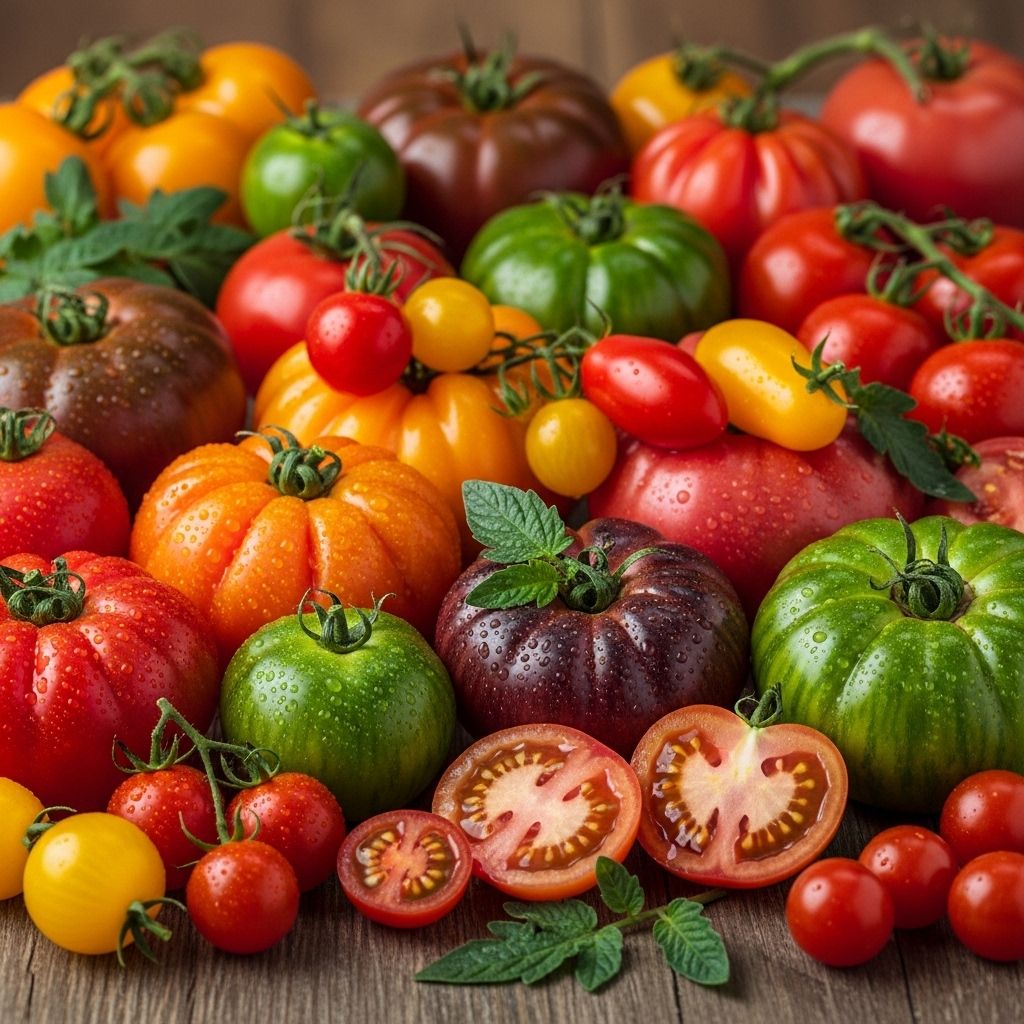Types of Tomatoes: The Complete Guide to Varieties & Classification
Organizing by fruit form, plant habit, and seed category guides harvests for flavor and culinary purposes.

Image: HearthJunction Design Team
Types of Tomatoes and Their Classifications
Tomatoes are one of the most beloved garden crops, notable for their incredible range of shapes, sizes, flavors, and culinary uses. With over 10,000 recognized varieties worldwide, the world of tomatoes can feel overwhelming to new and seasoned gardeners alike. Thankfully, most tomatoes fit into a few key categories based on fruit characteristics and plant growth habits, making it easier to select the perfect variety for your needs.
Why Classification Matters
Understanding the different types of tomatoes helps you not only choose the best seeds for your garden but also optimizes your harvest for specific recipes and preservation methods. Whether you’re looking for the perfect slicing tomato for sandwiches, a juicy cherry for salads, or a dense paste variety for sauces, knowing the distinctions can make all the difference.
Tomato Classifications
The primary ways to classify tomatoes include:
- Fruit shape and size
- Growth habit (determinate vs. indeterminate)
- Seed type (hybrid, open-pollinated, heirloom)
Six Main Types of Tomatoes by Shape
Most tomatoes fall into one of six common categories based on the size and shape of their fruits. Each category supports a range of flavors, colors, and culinary purposes.
1. Globe Tomatoes
Also known as slicing tomatoes, globe tomatoes are the most typical supermarket variety. They are medium-sized, round, and have a balanced sweet-acidic flavor, making them versatile for fresh eating, sandwiches, and salads.
- Size: Medium (5–8 oz.)
- Shape: Round, slightly flattened
- Colors: Primarily red, but also orange, pink, yellow, gold, or burgundy/purple
- Popular Varieties: ‘Celebrity’, ‘Early Girl’, ‘Beorange’, ‘Lemon Boy Plus’
2. Cherry Tomatoes
Cherry tomatoes are small, round, and grow in clusters, bursting with sweet, juicy flavor. They are perfect for snacking, salads, or roasting, and are favored for their prolific yields.
- Size: Small (<5 oz.)
- Shape: Round
- Popular Varieties: ‘Sun Gold’, ‘Supersweet 100’, ‘Gold Nugget’, ‘Cherry Bomb’
3. Grape Tomatoes
Grape tomatoes resemble cherry tomatoes but are more elongated and firm. They hold up well in salads and are less watery, making them excellent for snacking and lunchboxes.
- Size: Small
- Shape: Oval, grape-like
- Popular Varieties: ‘Five Star Grape’, ‘Nova’, ‘Red Pearl’
4. Beefsteak Tomatoes
Beefsteak tomatoes are the giants of the tomato world, known for their large, meaty fruits with few seeds. Their size and dense flesh make them the go-to choice for sandwiches and burgers.
- Size: Large (often >8 oz., can exceed 1 lb.)
- Shape: Broad, sometimes ribbed
- Popular Varieties: ‘Mortgage Lifter’, ‘Brandywine’, ‘Cherokee Purple’, ‘Big Beef’
5. Plum (Paste) Tomatoes
Plum or paste tomatoes are famously used for sauces, pastes, and canning. They are small, oval, and contain less water and fewer seeds, making them ideal for cooking and preserving.
- Size: Small to medium
- Shape: Oblong, cylindrical
- Popular Varieties: ‘San Marzano’, ‘Roma’, ‘Amish Paste’
6. Oxheart Tomatoes
Oxheart tomatoes are named for their heart-like shape. They are large, meaty, and similar to beefsteaks but often have a point at the base.
- Size: Large (often comparable to beefsteak)
- Shape: Heart-shaped, pointed at the base
- Popular Varieties: ‘Hungarian Heart’, ‘Oxheart Pink’
Tomato Colors: Beyond Red
While red is the classic tomato color, modern gardens can feature a spectrum of hues, each with unique flavors and nutrients:
- Yellow/Gold: Mild, low-acid, and slightly fruity (e.g., ‘Lemon Boy Plus’)
- Orange: Sweet, tropical notes (e.g., ‘Beorange’)
- Pink: Old-fashioned sweetness (e.g., ‘Brandywine Pink’)
- Burgundy/Purple: Rich, complex flavors (e.g., ‘Cherokee Purple’)
- Green: Tangy and tart, often bred to ripen green (e.g., ‘Green Zebra’)
- Striped/Bicolor: Eye-catching and often sweet (e.g., ‘Mr. Stripey’)
Tomato Growth Habits
Beyond fruit shape and size, tomatoes are often categorized by how they grow. This classification is vital for understanding planting, pruning, and harvesting schedules.
| Growth Habit | Description | Examples | Best Use |
|---|---|---|---|
| Determinate | Plants grow to a set height, then stop. Fruits ripen at once, producing a single main crop. | ‘Roma’, ‘Celebrity’, ‘Washington Cherry’ | Canning, sauces, limited space, container gardens |
| Indeterminate | Vining plants continue growing and producing fruit throughout the season. | ‘Sun Gold’, ‘Cherokee Purple’, ‘Brandywine’ | Fresh eating, salads, sandwiches, long harvest |
| Semi-Determinate | Plants have a main crop that ripens together, but continue to produce until frost. | Various hybrids | Versatile, extended harvests, compact habit |
Seed Types: Hybrid, Open-Pollinated, and Heirloom
Tomatoes can also be classified by the type of seed used to produce them, each with unique advantages.
- Hybrid: Bred by crossing two different varieties for vigor, disease resistance, and uniformity. Hybrids do not always breed true from saved seed.
- Open-Pollinated: Pollinated naturally, these varieties produce offspring true to type if isolated from other types. Good for seed saving.
- Heirloom: A type of open-pollinated tomato, often passed down through generations for unique flavors, colors, and shapes. Usually non-hybridized.
Popular Tomato Varieties and Their Uses
- ‘Mortgage Lifter’: Large, pink beefsteak tomato developed in the 1930s. Renowned for its size and low acidity, it produces 1 to 1½ lb fruits, ideal for slicing and canning.
- ‘Cherokee Purple’: An heirloom with a distinct purplish-red color, cherished for its sweet, robust flavor. Prone to cracking but worth the effort for its classic taste.
- ‘Sun Gold’: An indeterminate cherry tomato, prized for its vibrant orange color and exceptional sweetness. Great for fresh snacking and salads.
- ‘San Marzano’: A classic paste tomato from Italy, known for its dense, low-moisture flesh, perfect for sauces and canning.
- ‘Green Zebra’: A striking green striped tomato with tangy flavor, often eaten fresh or used in salsas.
Choosing the Right Tomato for Your Needs
When selecting tomato varieties, consider the following factors:
- Purpose: Is your main goal fresh eating, canning, sauces, or snacking?
- Space: Do you have room for sprawling indeterminate vines, or do you need compact, container-friendly determinates?
- Growing Conditions: Consider your climate, soil, and available sunlight.
- Taste Preferences: Some varieties are sweeter, others more acidic, and some have rich, complex flavors.
- Disease Resistance: Hybrids often have greater resistance to common tomato diseases.
Tips for Growing Healthy Tomatoes
- Start with healthy, disease-free seeds or transplants.
- Select a site with at least 6–8 hours of direct sunlight.
- Space plants appropriately to allow for airflow and reduce disease.
- Support indeterminate varieties with cages or stakes.
- Mulch to conserve moisture and suppress weeds.
- Water deeply and regularly, aiming for consistent soil moisture.
- Monitor for pests and diseases; rotate crops yearly for best results.
Frequently Asked Questions (FAQs)
Q: What is the difference between determinate and indeterminate tomatoes?
A: Determinate tomatoes produce a single large crop and then stop growing, making them ideal for canning or small spaces. Indeterminate tomatoes keep growing and producing fruit until frost, giving you a steady harvest all season long.
Q: Are heirloom tomatoes better than hybrids?
A: Heirloom tomatoes are prized for their unique flavors and history, while hybrids offer greater disease resistance and uniformity. The best choice depends on your priorities: flavor diversity or ease of growth.
Q: Can I grow different types of tomatoes together?
A: Yes, you can grow multiple types together. Just be sure to provide ample space, support for vining types, and consider the potential for cross-pollination if you plan to save seeds.
Q: Why do some tomatoes crack or split?
A: Cracking often occurs when tomatoes receive uneven watering, especially after dry spells followed by heavy rain. Certain varieties, such as ‘Cherokee Purple’, are more prone to cracking. Consistent soil moisture helps reduce this issue.
Q: What are the best tomatoes for sauces?
A: Paste tomatoes like ‘San Marzano’ or ‘Roma’ are ideal due to their dense flesh and low water content, resulting in thick, rich sauces.
Conclusion
With thousands of varieties and endless options, tomatoes are a joy for every gardener. Whether you’re drawn to the classic globe, adventurous with heirlooms, or passionate about canning, understanding the types and classifications is your first step toward a successful harvest. Experiment with different shapes, sizes, colors, and flavors to find the perfect tomato for your garden and kitchen!
References
Read full bio of Shinta












